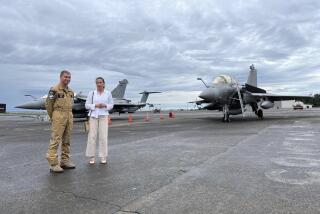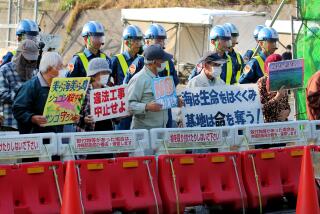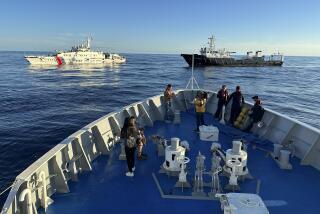NEWS ANALYSIS : U.S. Move to Back Aquino Could Prove Costly Later
WASHINGTON — Over the long run, the Bush Administration’s military intervention on behalf of President Corazon Aquino could, ironically, mark the beginning of the end of America’s 91-year involvement in the Philippines.
For now, the U.S. military move in Manila could help preserve the Aquino government and, with it, two strategic American military facilities, Clark Air Base and Subic Bay Naval Base. But the American military action also could accelerate forces, both in the Philippines and in Washington, leading to a reduction or pullout of U.S. forces over the coming decade.
Aquino’s need for U.S. Air Force warplanes to suppress a military revolt serves as the most graphic reminder yet of the dependent relationship between the Philippine government and the United States. Like the regime of Ferdinand E. Marcos in its final years, the Aquino government has demonstrated that it cannot survive without American backing.
It has been that way ever since May 1, 1898, when Commodore George Dewey and his fleet sailed into Manila Bay, sank a Spanish armada and seized America’s first overseas territory. As author Stanley Karnow recounted in his book, “In Our Image,” President William McKinley later explained that God had told him to annex the Philippines and “do the best we could for them.”
In recent years, a number of nationalist leaders in the Philippines have spoken of the importance of breaking the pattern of dependency on the United States. “We must slay the father image,” declared Foreign Secretary Raul Manglapus. The American military intervention is likely to intensify these nationalist sentiments among Filipino politicians.
In Washington, meanwhile, foreign-policy strategists have been warning that in the future, the United States should reduce its reliance on overseas bases such as those at Clark and Subic Bay, America’s two largest overseas military facilities.
“We should not ordinarily be dependent on bases in defending our interests in the Third World,” concluded the Commission on Integrated Long-Term Strategy, a private blue-ribbon panel that included former national security advisers Henry A. Kissinger, Zbigniew Brzezinski and William P. Clark, in a report two years ago. “We have found it increasingly difficult, and politically costly, to maintain bases there.”
This week’s coup attempt in Manila indicates that even now, despite all the U.S. efforts and money, the situation in the Philippines is, if anything, more politically fragile and unstable than ever.
Only three weeks ago, on the eve of a visit by Aquino to the White House, a Bush Administration official was asked whether her government had managed to improve the situation in the Philippine armed forces since an unsuccessful coup attempt in August, 1987.
“Since then, the state of civil-military relations (in the Philippines) has improved markedly,” declared the senior official. “I think morale within the armed forces, discipline, the sorts of things that are important for an effective force, are much greater now than they were, say, two or three years ago.”
The events of recent days show that the Bush Administration has been far too optimistic. And quiet U.S. efforts over the past few years to find alternatives to the bases in the Philippines are likely to take on special urgency now.
The U.S. lease for its bases in the Philippines--including not only Clark and Subic Bay but four smaller military facilities--expires in September, 1991. Discussions between the two governments about the future of the bases are scheduled to resume in Manila later this month.
The next presidential elections in the Philippines will be in 1992, and Aquino recently told The Times in an interview that she will not run for reelection. “I feel I have already done my duty insofar as being a citizen of this republic is concerned,” she said.
Philippine voters already have elected a Senate dominated by members opposed to continuation of the U.S. bases. And the future of the relationship between the Philippines and the United States will inevitably be one of the principal issues in the next presidential election there.
Over the past year, even middle-of-the-road Philippine politicians and military leaders have begun to call for a gradual elimination of the U.S. military presence during the 1990s.
Defense Secretary Fidel V. Ramos, one of the staunchest supporters of the United States among Philippine leaders, said early this year there should be a “phase-out” of the U.S. bases by 1998, the 100th anniversary of Dewey’s sail into Manila.
Similarly, last July, Vice President Salvador Laurel called for “at most, a 10-year phase-out of the bases.” In other words, the question among Philippine politicians seems to be shifting from whether the Americans should leave the bases to how soon.
At the same time, Washington officials have begun to take seriously the possibility that the United States could be forced to give up its bases in the Philippines, which are considered perhaps the most important American military facilities outside the United States.
One of the biggest problems is money. Last year, the United States concluded an agreement with the Philippines under which it is paying $481 million a year in aid for the bases until the current lease expires.
In addition, the United States has promised to contribute $200 million a year in economic aid to the Philippines as part of a multinational aid initiative aimed at buttressing the Philippine economy. But Congress has balked at contributing the money, and it is doubtful the United States will be able in the long run to keep increasing its payments to the Philippines.
“In the current budget environment, it’s not clear that the United States is going to fight as hard as it might have done to preserve bases if the Filipinos don’t want them,” Dov Zakheim, a former Ronald Reagan Administration defense official, said Friday.
Over the past few years, Pentagon planners have studied the possibility of relocating the American facilities to U.S. possessions in the Pacific.
“If you move back to Guam, Tinian or Saipan, you could carry out a lot of the functions of Clark (Air Base) with relative ease,” observed one senior Defense Department official. “The problem is replacing the ship-repair facilities at Subic Bay.”
Some U.S. defense strategists hope that eventually new, high-technology solutions will make bases like Clark and Subic Bay less important than they are now.
Last year, the Hudson Institute, a conservative-oriented think tank, said the development of hypersonic aerospace planes, which could travel halfway around the world in a few hours without refueling, would reduce the need for overseas bases.
The Hudson Institute report concluded that “the fruits of these technologies will probably not be available for at least a decade.” That prediction matches the timetable of the Philippine leaders who are calling for a gradual phase-out of the American military presence during the 1990s.
More to Read
Sign up for Essential California
The most important California stories and recommendations in your inbox every morning.
You may occasionally receive promotional content from the Los Angeles Times.










